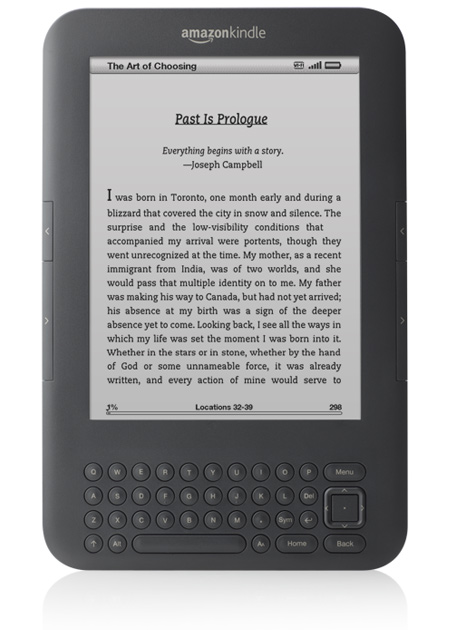



An E-Reader Convert
By Wayne Maruna
I didn’t think I would ever be interested in an e-reader. I’m one of those people who likes the physicality of holding a book, the variation in font size, thickness, smell. But then my father booked himself and his wife on a two week Alaskan/West Coast cruise and asked us to consider joining them. While we would have preferred a summertime cruise to Alaska, the chance to spend time with my mid-80s father who lives three time zones away won out. With two transcontinental flights and two weeks at sea staring me in the face, I knew I would want to bring along lots of reading material. But how to pack all that when my luggage bag was already weighing in at 46.5 pounds? I was in the midst of reading Tom Clancy’s Dead or Alive, all 950 pages glued into a three pound bundle. Nope, that was not going along.
So an e-reader seemed to be a logical choice, but what to buy? I turned to TabMail and the New Bern Computer User Group and posed the question. In total I received 30 responses. While there were a couple of off-brand readers available, I wanted to stick with one of the main brands for my first foray into electronic readers, so the choices quickly narrowed down to three: Amazon Kindle, Barnes & Noble Nook, and Apple iPad2.
Those choices could be alternately divided into two groups: E-ink readers and LCD screen devices. The Kindles, at the time I was looking, were all E-ink readers. They had a 6” screen model with a physical keyboard, and a 10” DX model, though at $379 the DX was quickly off my list. The B&N Nook, priced at $139, was a 6” display e-ink model. Unlike the Kindles, it featured a touch screen which I quickly realized was on my must-have list.




The E-ink models do not have backlighting. They rely on ambient lighting from lamps or the sun, just like a paper book. Because of this, they have very long battery life, measured in weeks rather than in hours. Power is only consumed when refreshing the screen, as in turning pages. LCD screens are backlit, which makes them brighter and more vivid but reduces battery life to seven to ten hours. I’d have to recharge the unit daily. The LCD screens are also reflective, so they can be annoying when trying to use outdoors.
I further thought that if I could convert my magazine subscriptions to electronic versions and do away with the resulting magazine clutter, I could better justify an e-reader purchase. But to do magazines justice, I would want a color capable device. B&N offered a color LCD model called the Nook Color at $250. This has a seven inch screen and some web browsing and email capability when accessing a wi-fi connection. Some shopping and testing proved to me that a seven inch screen was just not going to cut it, at least for me, when it came to viewing magazines. So that scratched the Nook Color and the smaller tablets. Ruthann England, a Taberna resident, was kind enough to let me test out magazines on her iPad, and the magazines looked terrific. I quickly decided that if I wanted magazines, an iPad2 was the way to go. But wait. Electronic magazine subscriptions turned out to be more expensive than their paper counterparts, which seemed counter-intuitive. Plus, my smart phone could do just about everything the iPad2 could do, albeit on a 4” screen rather than on a near-ten inch screen. Could I justify $500 to $600? I could not.
So it was back to basics. To cut to the chase, I purchased the Nook Simple Touch and I’m happy with my decision. It is very light (7.5 ounces), easy to hold and view, small enough to fit in a front pants pocket, and I love the touch screen feature, though I quickly learned to put it in screen saver mode before pocketing it, as even subtle movements could cause inadvertent paging if I left the unit ‘live’. If I could improve one thing, it would be to lighten the page background, which is a bit too gray for my liking.
Of course, now that I have paid out my money, the competition offerings have improved. Amazon recently announced new models, including a touch screen version of the Kindle at a $99 price point, and their own 7” screen color LCD tablet called Kindle Fire at $199 which might spell the death of the $249 Nook Color (although check out this link to learn how to turn a Nook Color into a full-fledged Android tablet for as little as $35. http://www.pcworld.com/article/241726/how_to_clean_your_lcd_root_a_nook_load_linux_on_a_netbook.html#tk.nl_sbx_h_crawl ) Both these new models will be available mid-November 2011. Available now is a non-touch screen virtual keyboard model Kindle for $79. Rumor has it that B&N is readying two new models for pre-holiday release. The E-reader wars are officially on. I expect basic e-reader prices to continue to fall. They have all the earmarks of another scenario akin to selling cheap razors to get you to buy marked up razor blades. After all, I’m now buying books through electronic downloads rather than getting their paper counterparts free at the library or dirt cheap at flea markets.